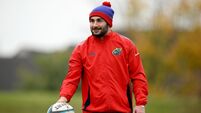PM O'Sullivan: Kilkenny hurling seems in limbo, caught between two shores

Kilkenny backs and Galway forwards vie for possession of the sliotar during the Leinster final. Picture: Ray McManus/Sportsfile
Some years ago, I interviewed Richie Hogan.
First noticed? His hands. They were like slabs, matted hair on the back, twice as big as regular issue.











